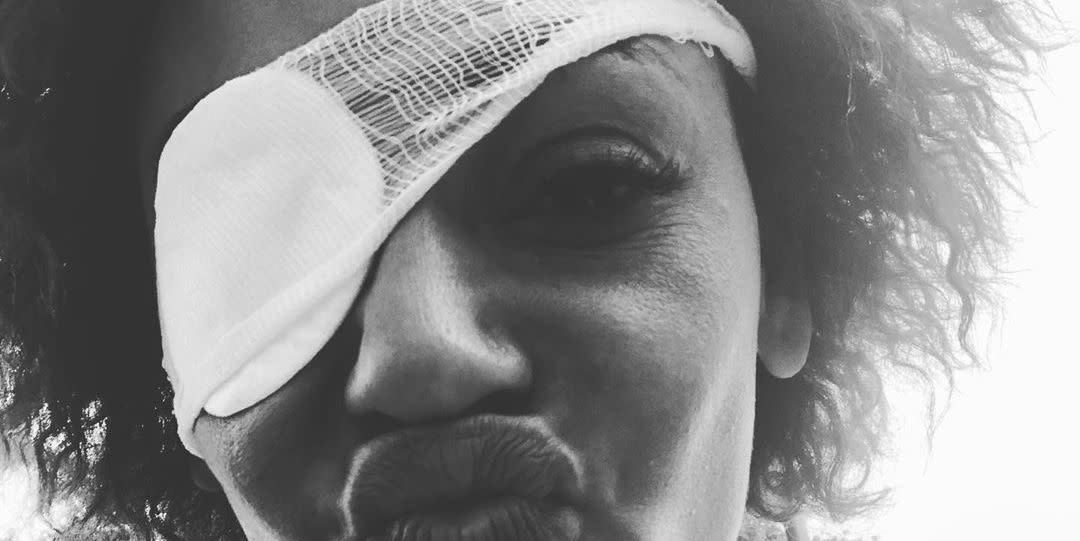Mel B Says “Severe Iritis” Temporarily Made Her Go Blind in One Eye: “I Was Very Scared”

Mel B revealed on Instagram that she went temporarily blind in one eye due to inflammatory conditions called iritis and uveitis.
She said: “I had an awful experience last week when I went blind in my right eye and my left eye went blurry,” adding that she was “not ok” at the time.
An optometrist explains the symptoms of iritis and uveitis and what treatment typically looks like.
Fans were concerned after reports surfaced that Melanie Brown (aka Mel B) of the Spice Girls went temporarily blind in one eye. Well, Brown is addressing the reports and, it turns out, they’re true.
Brown shared a photo of herself wearing an eye patch on Instagram Tuesday morning and addressed her eye health in the caption. “I had an awful experience last week when I went blind in my right eye and my left eye went blurry,” she wrote. “Just to be clear I was NOT ok and this has NEVER EVER happened to me before.”
Brown, 43, said she was “in a lot of pain and very, very scared” but was eventually diagnosed with “severe iritis” in her right eye and uveitis in her left eye. “I’m taking multiple prescription heavy duty eye drops and other medication the dr gave me that I have to take every day to keep the inflammation under control,” she said.
Brown said she’s “still dealing with it and will be for the next three to four months” but she’s “no longer worried that my condition will get worse.” Now, she joked, she’s trying to find a cool eye patch to wear while she heals.
A post shared by Scary Spice Mel b (@officialmelb) on May 21, 2019 at 4:43am PDT
It’s terrifying to think that you could suddenly go blind in one eye. So, what’s going on here?
What is iritis and uveitis?
Iritis is inflammation of the iris of your eye, i.e. the colored part, says Aaron Zimmerman, OD, a professor of clinical optometry at The Ohio State University. Iritis is actually a form of uveitis, which is a general term used to describe a group of inflammatory diseases that cause swelling and destroys eye tissues, per the National Eye Institute (NEI).
The uvea is made up of the iris, ciliary body, and the choroid (blood supply to part of the retina), Dr. Zimmerman explains. Inflammation of the area can happen in one of the three or all three, leading to uveitis, he says.
What causes iritis and uveitis?
There’s actually a pretty wide range. Dr. Zimmerman says uveitis can be sparked by trauma to the eye, post-surgical issues, an autoimmune disease, or unknown causes. But, when it shows up in both eyes and is severe, it’s more likely to be due to an autoimmune condition, he says.
What are the symptoms of iritis and uveitis?
People with uveitis can have decreased vision, pain, light sensitivity, and floaters in their eyes, the NEI says. Anyone can experience uveitis, but it largely impacts people between the ages of 20 and 60.
It’s scary that Brown’s eye problems came on so quickly, but it can happen. “It can be somewhat gradual or relatively fast,” Dr. Zimmerman says. “Usually inflammation of the eye is uncomfortable, so patients try to be seen relatively quickly.”
Treatment for uveitis varies, but doctors will generally use eye drops and medication that work to eliminate inflammation, alleviate pain, prevent further tissue damage, and restore any loss of vision you might be having, the NEI says.
If you’re having pain or vision issues, call your eye doctor ASAP. There’s a chance it could be due to uveitis or another serious health condition. Either way, you don’t want to sit on it.
Stay updated on the latest science-backed health, fitness, and nutrition news by signing up for the Prevention.com newsletter here. For added fun, follow us on Instagram.
('You Might Also Like',)

